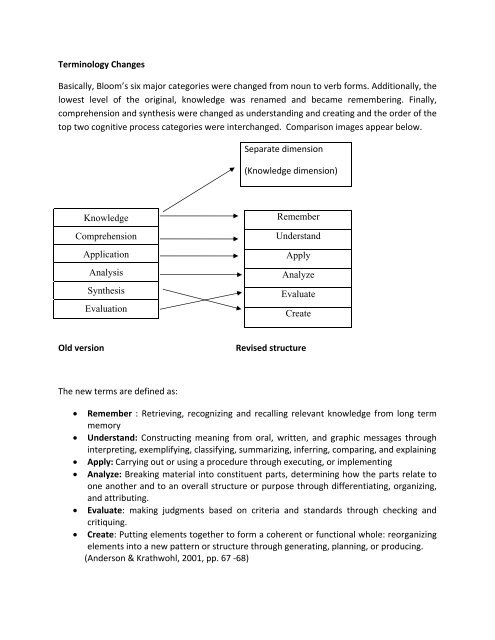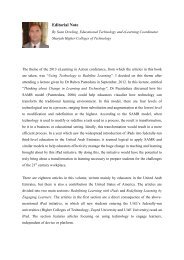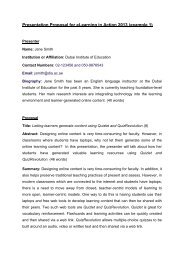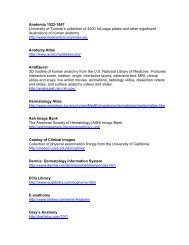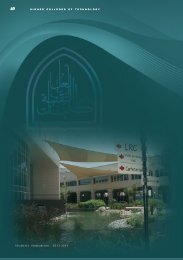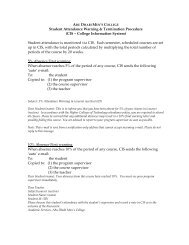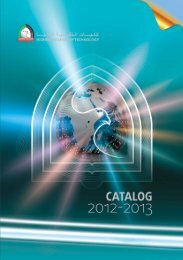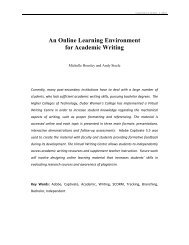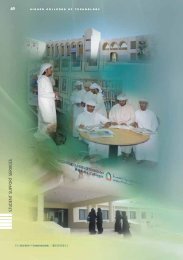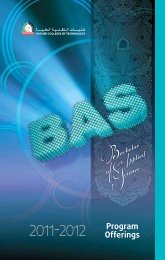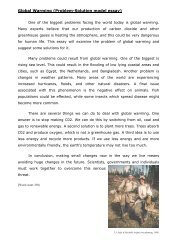to read more about the revised Bloom's taxonomy (PDF)
to read more about the revised Bloom's taxonomy (PDF)
to read more about the revised Bloom's taxonomy (PDF)
You also want an ePaper? Increase the reach of your titles
YUMPU automatically turns print PDFs into web optimized ePapers that Google loves.
Terminology Changes<br />
Basically, Bloom’s six major categories were changed from noun <strong>to</strong> verb forms. Additionally, <strong>the</strong><br />
lowest level of <strong>the</strong> original, knowledge was renamed and became remembering. Finally,<br />
comprehension and syn<strong>the</strong>sis were changed as understanding and creating and <strong>the</strong> order of <strong>the</strong><br />
<strong>to</strong>p two cognitive process categories were interchanged. Comparison images appear below.<br />
Separate dimension<br />
(Knowledge dimension)<br />
Knowledge<br />
Comprehension<br />
Application<br />
Analysis<br />
Syn<strong>the</strong>sis<br />
Evaluation<br />
Remember<br />
Understand<br />
Apply<br />
Analyze<br />
Evaluate<br />
Create<br />
Old version<br />
Revised structure<br />
The new terms are defined as:<br />
• Remember : Retrieving, recognizing and recalling relevant knowledge from long term<br />
memory<br />
• Understand: Constructing meaning from oral, written, and graphic messages through<br />
interpreting, exemplifying, classifying, summarizing, inferring, comparing, and explaining<br />
• Apply: Carrying out or using a procedure through executing, or implementing<br />
• Analyze: Breaking material in<strong>to</strong> constituent parts, determining how <strong>the</strong> parts relate <strong>to</strong><br />
one ano<strong>the</strong>r and <strong>to</strong> an overall structure or purpose through differentiating, organizing,<br />
and attributing.<br />
• Evaluate: making judgments based on criteria and standards through checking and<br />
critiquing.<br />
• Create: Putting elements <strong>to</strong>ge<strong>the</strong>r <strong>to</strong> form a coherent or functional whole: reorganizing<br />
elements in<strong>to</strong> a new pattern or structure through generating, planning, or producing.<br />
(Anderson & Krathwohl, 2001, pp. 67 ‐68)
Structural changes<br />
Bloom’s original cognitive <strong>taxonomy</strong> was a one‐ dimensional form. With <strong>the</strong> addition of<br />
products, <strong>the</strong> <strong>revised</strong> Bloom’s <strong>taxonomy</strong> takes <strong>the</strong> form of a two‐dimensional table. One of <strong>the</strong><br />
dimensions identifies <strong>the</strong> Knowledge Dimension (or <strong>the</strong> kind of knowledge <strong>to</strong> be learned) while<br />
<strong>the</strong> second identifies <strong>the</strong> Cognitive Process Dimension (or <strong>the</strong> process used <strong>to</strong> learn). As<br />
represented on <strong>the</strong> grid below, <strong>the</strong> intersection of <strong>the</strong> knowledge and cognitive process<br />
categories form twenty‐four separate cells.<br />
The Knowledge Dimension on <strong>the</strong> left side is comprised of four levels that are defined as<br />
Factual, Conceptual, Procedural, and Meta‐Cognitive. Process Dimension across <strong>the</strong> <strong>to</strong>p of <strong>the</strong><br />
grid consists of six levels that are defined as Remember, Understand, Apply, Analyze, Evaluate,<br />
and Create. Each level of both dimensions of <strong>the</strong> table is subdivided.<br />
THE<br />
KNOWLEDGE<br />
DIMENSION<br />
THE COGNITIVE PROCESS DIMENSION<br />
1.REME<br />
M BER<br />
2.UNDER<br />
STAND<br />
3.APPLY 4.ANALYZE 5.EVALUATE 6.CREATE<br />
A. FACTUAL<br />
KNOWLEDGE<br />
B. CONCEPTUAL<br />
KNOWLEDGE<br />
C. PROCEDURAL<br />
KNOWLEDGE<br />
D. META-<br />
COGNITIVE<br />
KNOWLEDGE<br />
Table 4.1: The <strong>taxonomy</strong> table (from Anderson et al 2001)
Knowledge Dimension<br />
In <strong>the</strong> <strong>taxonomy</strong> table <strong>the</strong> knowledge Dimension is described as Factual, Conceptual,<br />
Procedural, and Meta cognitive as four general types of knowledge Factual and Conceptual<br />
knowledge are most similar in that <strong>the</strong>y involve <strong>the</strong> knowledge of “what”’ although conceptual<br />
knowledge is a deeper, <strong>more</strong> organized, integrated, and systematic knowledge than just<br />
knowledge of terminology and isolated facts. Procedural knowledge is <strong>the</strong> knowledge of “how”<br />
<strong>to</strong> do something. These three categories were all represented in <strong>the</strong> original Taxonomy.<br />
Reflecting recent cognitive science and cognitive psychological research on <strong>the</strong> importance of<br />
Meta cognition, Anderson et al. added a fourth category: meta cognitive knowledge. Meta<br />
cognitive knowledge reflects recent research on how students’ knowledge <strong>about</strong> <strong>the</strong>ir own<br />
cognition and control of <strong>the</strong>ir own cognition play an important role in learning (Bransford‐<br />
Brown & Cocking 1999: Sternberg 1985: Zimmerman & Schunk 1998, cited in Anderson et al,<br />
2001)<br />
Meta‐ Cognitive knowledge does not have <strong>the</strong> same status as <strong>the</strong> o<strong>the</strong>r three types of<br />
knowledge. These three types of knowledge were developed through consensus within a<br />
scientific or disciplinary community. This is clearly not <strong>the</strong> case with meta cognitive knowledge<br />
which is based on an individual’s own self awareness and <strong>the</strong> knowledge base has been<br />
developed within different communities (Anderson et al., 2000)<br />
Four types of knowledge are defined as.<br />
A. FACTUAL KNOWLEDGE : The basic elements students must know <strong>to</strong> be acquainted<br />
with a discipline or solve problems in it.<br />
Consists of<br />
• Knowledge of terminology<br />
• Knowledge of specific details and elements<br />
B. CONCEPTUAL KNOWLEDGE : The inter‐relationships among <strong>the</strong> basic elements within a<br />
larger structure that enable <strong>the</strong>m <strong>to</strong> function <strong>to</strong>ge<strong>the</strong>r<br />
Consists of<br />
• Knowledge of classifications and categories<br />
• Knowledge of principles and generalizations<br />
• Knowledge of <strong>the</strong>ories, models, and structures
C. PROCEDURAL KNOWLEDGE : How <strong>to</strong> do something, methods of inquiry, and criteria for<br />
using skills, algorithms, techniques, and methods<br />
Consists of<br />
• Knowledge of subject‐ specific skills and<br />
algorithms<br />
• Knowledge of subject‐ specific techniques and<br />
methods<br />
• Knowledge of criteria for determining when <strong>to</strong><br />
use appropriate procedures<br />
D. METACOGNITIVE KNOWLEDGE: Knowledge of cognition in general as well as awareness<br />
and knowledge of one’s own cognition consists of<br />
Consists of<br />
• Strategic knowledge<br />
• Knowledge <strong>about</strong> cognitive tasks, including<br />
appropriate contextual and conditional<br />
knowledge<br />
• Self‐ Knowledge<br />
How can Bloom’s Taxonomy be used?<br />
The <strong>taxonomy</strong> table makes teachers aware of <strong>the</strong> possibility and desirability of including <strong>more</strong><br />
complex cognitive process categories, which promote critical thinking, problem solving and<br />
higher‐Level thinking in classroom instruction and assessment. It points <strong>to</strong> <strong>the</strong> necessity of<br />
considering complex cognitive processes in terms of knowledge. It provides an easy way for<br />
teachers <strong>to</strong> use activities <strong>to</strong> infer objectives. If a teacher knows that a specific objective is of <strong>the</strong><br />
form remember factual knowledge, understand conceptual knowledge, or apply procedural<br />
knowledge, <strong>the</strong>n <strong>the</strong> teacher may make some assumptions <strong>about</strong> how <strong>to</strong> teach and assess that<br />
learning outcome. It will help <strong>to</strong> develop assessment tasks for learning outcomes that include<br />
<strong>the</strong> types of knowledge in terms of complex cognitive process.
The knowledge and cognitive process dimensions intersect in <strong>the</strong> cells of <strong>the</strong> <strong>taxonomy</strong> table.<br />
Learning outcomes ei<strong>the</strong>r explicitly or implicitly include both knowledge and cognitive<br />
processes that can be classified in <strong>the</strong> <strong>taxonomy</strong> framework. Learning outcomes can be placed<br />
in <strong>the</strong> cells, and placing a learning outcome in<strong>to</strong> <strong>the</strong> framework increases <strong>the</strong> understanding of<br />
that learning outcome. Different types of learning outcomes require different instructional<br />
approaches, that is, different learning activities and different teacher and pupil roles. Classifying<br />
a particular learning outcome within <strong>the</strong> framework, <strong>the</strong>refore, helps teachers <strong>to</strong> systematically<br />
plan a way of effectively facilitating pupil’s learning of that learning outcome. Different types of<br />
learning outcomes (learning outcomes in <strong>the</strong> different cells of <strong>the</strong> table) require different<br />
approaches <strong>to</strong> assessment. (Anderson et al 2001)


